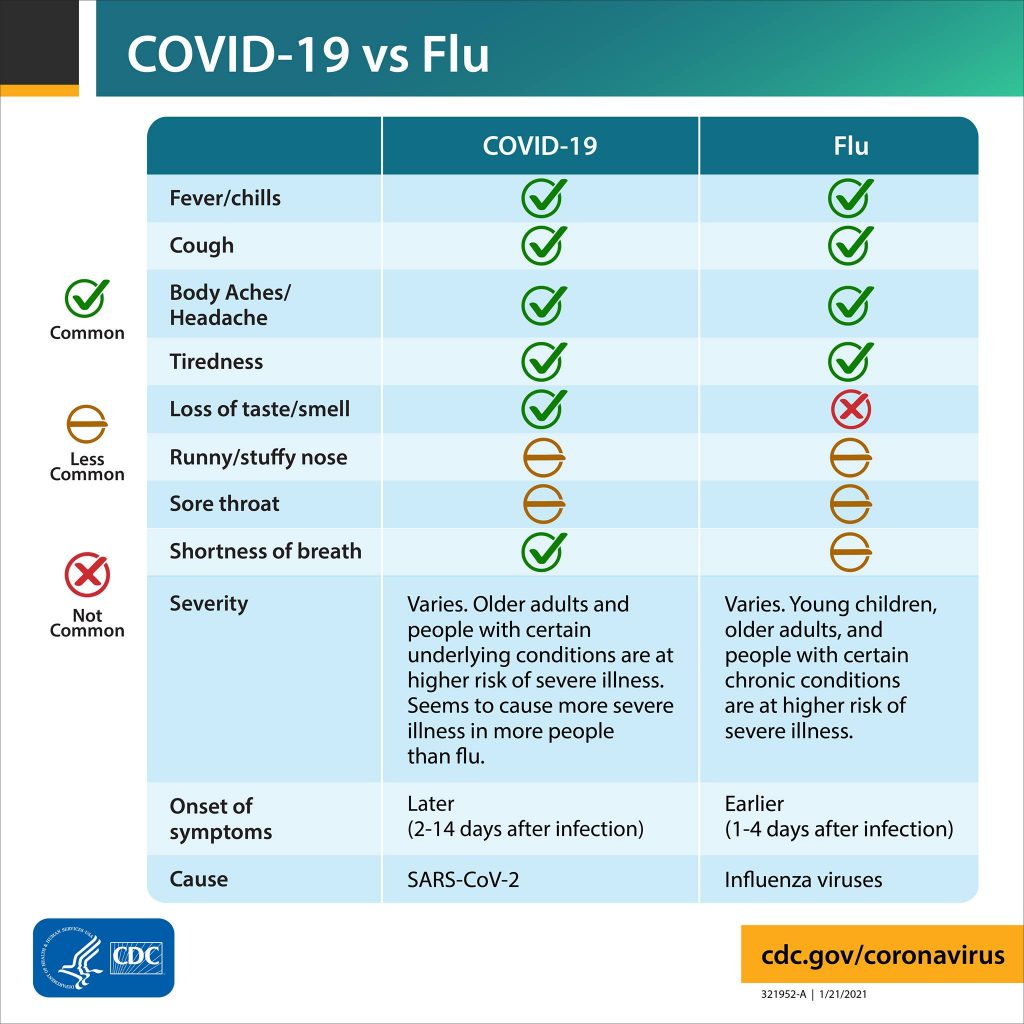There are quite a few similarities between COVID-19 and the flu. Both are contagious respiratory illnesses. Both have a similar set of symptoms. However, different viruses cause the illnesses. We are consistently learning more about COVID-19 and the virus that causes it. But there are still a lot of unknowns. In this article, we go over what has been learned so far about the differences and similarities that will help you know which is which during the flu season.
Symptoms
When COVID-19 first hit, many people had a tough time telling the difference between that and seasonal allergies. Now we’ll be dealing with the same thing regarding the flu — especially in the beginning stages of the illness. Symptoms that are common to both illnesses include fever, headaches, body aches, sore throat, cough, shortness of breath, tiredness, vomiting, and diarrhea. On the other hand, there are two big differences.
Number one is the loss of taste and smell. This usually does not come with the flu. And it doesn’t happen in all COVID-19 cases either. Studies show that about 40 percent of people experience the loss of smell. While 40-50 percent of people say they lost their sense of taste.
Secondly, the symptoms are very different depending on the individual patient. For example, COVID-19 and the flu both include a cough and shortness of breath. The difference is that they may last much longer in COVID-19 cases. The same goes for the shortness of breath. It is frequently more severe and lasts longer than it does in flu cases.

More Symptoms
In addition to those listed above, there are some more symptoms that appear to be linked with COVID-19 that you should be aware of. They include the following.
- Eyes. Some COVID-19 patients have experienced red, swollen, and itchy eyes. In fact, it may be enough to look like pink eye.
- Rash. It would not be considered unusual for a rash to develop along with the flu or COVID-19. This symptom has been more common in younger people. If your child shows any new types of rash or skin condition, give us a call to see if a COVID-19 test should be administered.
COVID-19 vs Flu In Kids
One of the interesting aspects of COVID-19 is that it is generally less severe in kids than in adults. Children are just about two percent of the reported cases around the world. But there is one thing to be on the lookout for.
It’s called multi-system inflammatory syndrome in children (MIS-C). This is a rare condition that is associated with COVID-19 and affects children from toddlers to teens weeks or months following their initial illness. The symptoms are fever, vomiting, lethargy, and abdominal pain. If your child has these issues in addition to flu-like symptoms, come see us.
- Time for symptoms to appear. For both illnesses, one or more days can pass from the time someone is infected and the time they start to experience symptoms. With the flu, it happens in 1-4 days. For COVID-19, it can be anywhere from 2-14 days.
- How long you can spread the virus. Both viruses can be spread for at least a day before symptoms are shown. But with COVID-19, people are contagious for longer than the flu. And the length of time that the virus can be spread is still being investigated. However, we know that it may be for about two days before symptoms and up to 10 days or more after symptoms.
- How the virus is spread. They both spread from one person to another when they are in close contact. This happens through droplets that spread when an infected person coughs, sneezes, or even from talking. Another possible form of transmission is through touching another person or touching something they have also touched.
- High-risk groups. For both illnesses, high-risk categories include older adults, obesity, those with specific underlying medical conditions, and pregnant women. In this case, the risk for healthy kids is higher in the flu than with COVID-19.
- Complications. There are a lot of complications that can come from either illness. Here’s a list.
- Pneumonia
- Respiratory failure
- Acute respiratory distress syndrome (fluid in the lungs)
- Sepsis
- Cardiac injury (heart attacks, stroke)
- Multiple-organ failure (respiratory failure, kidney failure, shock)
- Worsening of chronic medical conditions (involving the lungs, heart, or nervous system or diabetes)
- Inflammation of the heart, brain, or muscle tissues
- Secondary bacterial infections
Plus, these additional complications can be related to COVID.
- Blood clots in the veins and arteries of the lungs, heart, legs, or brain
- Multisystem Inflammatory Syndrome in Children (MIS-C)
Vaccine. Vaccines are available for both the flu and COVID-19. Every year there are multiple flu vaccines available. So far, two vaccines have been approved by the FDA and more are still being developed. At this point, there are no COVID-19 vaccines approved for children under 16 years of age.

What Should You Do?
If you or your child is showing the symptoms discussed above, what should you do next? We suggest taking the following steps to determine whether it is COVID-19 or the flu.
- First, speak to a doctor. When these kinds of symptoms show up, do not wait to talk to the doctor. And make sure that the person with the illness keeps a mask on and isolates themself from others in the family as much as possible. See this article for some tips on helping your kids deal with wearing a mask.
- Second, get tested to find out for sure. And the sooner the better. Fortunately, the nose swab test will give you results for both the flu and COVID-19. We have in-house testing available to help determine if a person has COVID-19, or has previously been infected.
- Third, get treatment. Once you know for sure if it is COVID-19 or the flu, you can begin with the appropriate treatment. For the flu, you may treat it with an antiviral drug. For COVID-19, you’ll probably be able to recover at home with monitored symptoms, hydration, and rest.
But if there are signs of difficulty breathing, chest pressure, inability to stay awake, or blue coloring in the lips or face — get emergency medical care immediately.
Tips To Protect Yourself
For months, experts have cautioned us about the possibility of flu season combining with COVID-19 to make things really bad. In order to avoid fighting the flu and COVID-19, follow these precautions.
- Get your flu shot. You might be waiting for a chance to get the COVID-19 vaccine, but you don’t have to do that for the flu. We offer seasonal flu vaccines for your kids. We suggest prevention of getting the flu virus by getting a flu vaccine once each year — and especially this year.
- Take precautions. You’ve heard it a thousand times so what’s the harm in one more? The best ways to prevent getting sick are to wear a mask, practice social distancing, wash your hands, and avoid large crowds.
Strengthen your immune system. Eating a healthy diet, getting enough exercise, and plenty of sleep will give your body better odds of keeping you healthy.
Just 4 Kids Urgent Care
We hope this will help you identify and understand the differences between COVID-19 and the flu. If you have any questions or need help, please feel free to give us a call or come and see us. We are here to help you take care of your child and have peace of mind in the process. Take a look at these additional resources for help with your kids.
